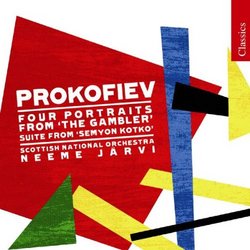| All Artists: Prokofiev, Jarvi, Scottish National Orchestra Title: Prokofiev: Four Portraits From 'The Gambler'; Suite from 'Semyon Kotko' Members Wishing: 0 Total Copies: 0 Label: Chandos Original Release Date: 1/1/2008 Re-Release Date: 8/26/2008 Genre: Classical Styles: Historical Periods, Modern, 20th, & 21st Century, Symphonies Number of Discs: 1 SwapaCD Credits: 1 UPC: 095115148525 |
Search - Prokofiev, Jarvi, Scottish National Orchestra :: Prokofiev: Four Portraits From 'The Gambler'; Suite from 'Semyon Kotko'
 | Prokofiev, Jarvi, Scottish National Orchestra Prokofiev: Four Portraits From 'The Gambler'; Suite from 'Semyon Kotko' Genre: Classical |
Larger Image |
CD DetailsSimilar CDs
|
CD ReviewsVivid Performances of Two Prokofiev Scores Rescued from Near J Scott Morrison | Middlebury VT, USA | 09/19/2008 (5 out of 5 stars) "The music on this CD was originally recorded in 1990 and issued on Chandos to universal praise. Neeme Järvi and the Royal Scottish National Orchestra had been recording Prokofiev orchestral scores for several years and they clearly had gotten the style and feel of the music in their bones. The scores on this disc -- Symphonic Suite from 'Semyon Kotko' and Four Portraits from 'The Gambler' -- are taken from not very well-known operas by the composer.
'Semyon Kotko' was written in the late 1930s and first produced in 1940. The opera is in more than forty scenes, almost cinematic in their impact. Prokofiev took almost intact music from seven of them, plus the opera's overture and the first act's prelude. The opera is the story of a peasant, Semyon Kotko, who returns from serving in World War I only to find that in the latter days of the War the Germans are invading his own village. The plot concerns both his love for and marriage with a landowner's daughter and with the destruction of Kotko's village and his capture. The opera ends in an apotheosis of Socialist Realism with the triumph of the Red Army. The music is very descriptive and particularly notable are the Overture, the intermezzo called 'The Southern Night', the depiction of 'The Village is Burning' and the 'Funeral' of one of the villagers. The suite contains some of Prokofiev's loveliest lyrical moments, but it also contains a good deal of anguished, even violent, music. 'The Gambler' was written twenty years earlier than 'Semyon Kotko', when Prokofiev was in his mid-twenties. Although placed in rehearsals, its premiere was prevented by the outbreak of the Revolution. Indeed, it never had a performance in the Soviet Union until a radio broadcast in 193. Its stage premiere was in Brussels in 1929. Prokofiev extracted four 'portraits' of characters in the opera and this suite was premiered in 1932 in Paris. The plot of the opera concerns a General, his children, their tutor Alexey and his lover Pauline, as well as the General's strong-willed but hapless Grandmother. These four characters' portraits make up the suite which then concludes with music taken from the opera's two entr'actes. The music portrays the General's fecklessness, Alexey's passion for both Pauline and for gambling, Pauline's painful recognition that the roulette wheel has enslaved Alexey, and the Grandmother's domineering personality. As far as I know this is the only currently available recording of the suite. It certainly makes a case for this music. There are recordings of the entire operas 'The Gambler' Prokofiev - The Gambler / Galusin, Kazarnovskaya, Aleksashkin, Obraztsova, Gergiev and of 'Semyon Kotko' Prokofiev: Semyon Kotko, both conducted by Valery Gergiev, but I have not heard them. An easy recommendation for those who love Prokofiev's other orchestral works. Scott Morrison" |



